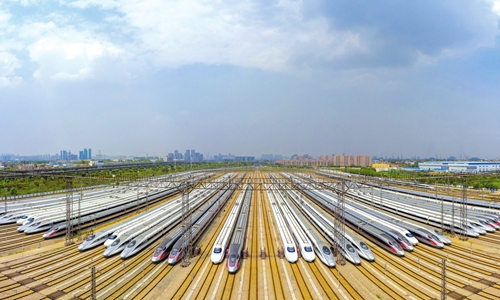HOME >> CHINA
Cities cautiously welcome Wuhan returnees
By Liu Caiyu in Beijing and Zhao Yusha in Wuhan Source:Global Times Published: 2020/4/8 19:58:41
Travelers must take COVID-19 tests before leaving amid concerns over silent carriers

The high-speed railway station in Wuhan, Central China's Hubei Province on Tuesday. China will lift lockdown on Wuhan, the city at center of China's virus outbreak. Photo: cnsphoto
As the lockdown in Wuhan ended on Wednesday, cities across China are taking a cautious attitude to welcome returnees from Wuhan, with many cities requiring them to take COVID-19 tests before leaving amid growing concerns over asymptomatic carriers.
People in Wuhan who want to go to Beijing have to apply online first and hand over a negative result from nucleic acid tests that took seven days ahead before being able to buy a ticket and get on a train to Beijing. Upon arrival, local community staff in Beijing will pick them up from train stations and take them directly to their home for a 14-day home quarantine.
Beijing also restricts the number of people from Wuhan to 1,000 a day, either by public transportation or driving. More than 11,000 people are waiting to get back to the capital from Wuhan, the Beijing government said on Wednesday at a press conference.
Amid the lifted lockdown, Shanghai government also said Wednesday it encourages enterprises to conduct COVID-19 tests to people who return to work and local medical institutes need to raise their alert to screen and test suspected patients.
For cities in South China's Guangdong Province, including Guangzhou, Shenzhen, Zhongshan and Zhanjiang, returnees from Wuhan have to show their recent nucleic acid tests upon arrival and to retest seven days later.
Moreover, returnees from Wuhan to Zhongshan, Guangdong need to hand over nucleic acid tests taken at Wuhan medical institutes within seven days and report their body temperatures three times a day on an online app for at least three days.
Zhou Zixiao, deputy director of Guangdong Health Commission, said at a Wednesday press conference that around 100,000 people from Wuhan are expected to return to Guangdong Province in the coming days.
Facing those precautionary measures, Wuhan people were seen in front of hospitals waiting to get COVID-19 tests and CT scans before leaving the city, the Global Times reporter saw on Wednesday in Wuhan.
Despite all the procedures, people are swarming to train stations and airports, which are only open to those with green QR health codes.
On the first day of the lifting of the lockdown, more than 55,000 passengers on 276 trains were expected to leave Wuhan, 40 percent of whom heading for the Pearl River Delta region, according to China Railway Wuhan Administration.
As one of the three train stations in Wuhan, Wuhan Railway Station alone sent over 24,000 passengers to other Chinese cities on the first day of the lifting, the railway station told the Global Times.
However, health experts warned on Wednesday that cities in China should remain cautious in epidemic control.
Despite the lifting of the lockdown, the battle against the epidemic is not over. Cities need to be vigilant over asymptomatic carriers, who are contagious despite their low infectivity, warned Zhou Zijun, a professor at the Peking University School of Public Health.
"The proportion of asymptomatic virus carriers in Wuhan should be higher than that of other regions in China. The outflow may pose risks to other cities," Zhou told the Global Times.
Hubei Province and Wuhan should ensure that the epidemic does not rebound as the city restarts. Local health authorities across China should strengthen their report on asymptomatic infections and ant-epidemic measures at important venues, officials from the NHC said late Tuesday.
Yang Jiong, an expert on respiratory studies at the Wuhan-based Zhongnan Hospital, said asymptomatic infections in Wuhan accounted for about 0.15 -0.3 percent of the city population, which means there are about 10,000 to 20,000 asymptomatic carriers in the city.
Newspaper headline: Returnees cautiously welcomed
RELATED ARTICLES:
Posted in: SOCIETY,CHINA FOCUS